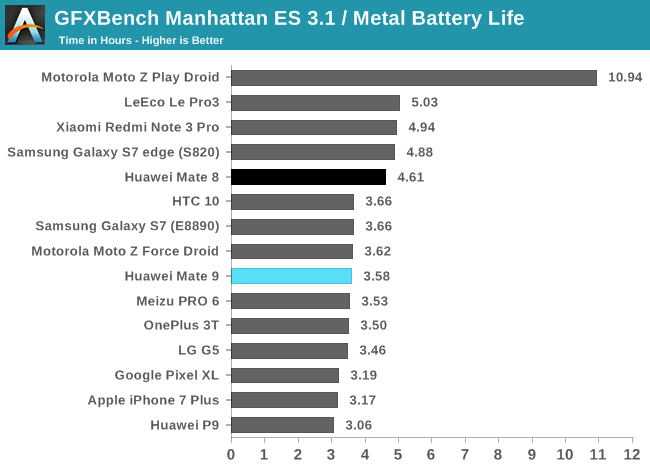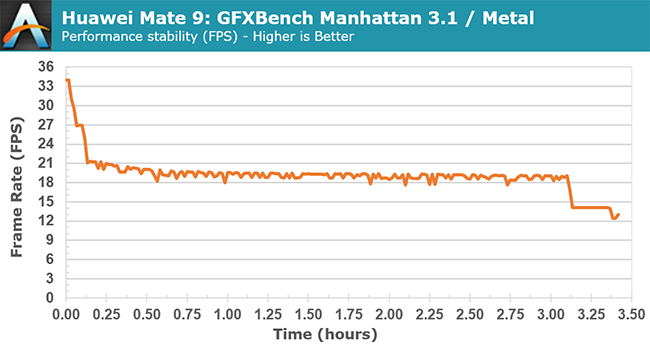HiSilicon Kirin 960: A Closer Look at Performance and Power
by Matt Humrick on March 14, 2017 7:00 AM EST- Posted in
- Smartphones
- Mobile
- SoCs
- HiSilicon
- Cortex A73
- Kirin 960
GPU Power Consumption and Thermal Stability
GPU Power Consumption
The Kirin 960 adopts ARM’s latest Mali-G71 GPU, and unlike previous Kirin SoCs that tried to balance performance and power consumption by using fewer GPU cores, the 960’s 8 cores show a clear focus on increasing peak performance. More cores also means more power and raises concerns about sustained performance.
We measure GPU power consumption using a method that’s similar to what we use for the CPU. Running the GFXBench Manhattan 3.1 and T-Rex performance tests offscreen, we calculate the system load power by subtracting the device’s idle power from its total active power while running each test, using each device’s onboard fuel gauge to collect data.
| GFXBench Manhattan 3.1 Offscreen Power Efficiency (System Load Power) |
||||
| Mfc. Process | FPS | Avg. Power (W) |
Perf/W Efficiency |
|
| LeEco Le Pro3 (Snapdragon 821) | 14LPP | 33.04 | 4.18 | 7.90 fps/W |
| Galaxy S7 (Snapdragon 820) | 14LPP | 30.98 | 3.98 | 7.78 fps/W |
| Xiaomi Redmi Note 3 (Snapdragon 650) |
28HPm | 9.93 | 2.17 | 4.58 fps/W |
| Meizu PRO 6 (Helio X25) | 20Soc | 9.42 | 2.19 | 4.30 fps/W |
| Meizu PRO 5 (Exynos 7420) | 14LPE | 14.45 | 3.47 | 4.16 fps/W |
| Nexus 6P (Snapdragon 810 v2.1) | 20Soc | 21.94 | 5.44 | 4.03 fps/W |
| Huawei Mate 8 (Kirin 950) | 16FF+ | 10.37 | 2.75 | 3.77 fps/W |
| Huawei Mate 9 (Kirin 960) | 16FFC | 32.49 | 8.63 | 3.77 fps/W |
| Galaxy S6 (Exynos 7420) | 14LPE | 16.62 | 4.63 | 3.59 fps/W |
| Huawei P9 (Kirin 955) | 16FF+ | 10.59 | 2.98 | 3.55 fps/W |
The Mate 9’s 8.63W average is easily the highest of the group and simply unacceptable for an SoC targeted at smartphones. With the GPU consuming so much power, it’s basically impossible for the GPU and even a single A73 CPU core to run at their highest operating points at the same time without exceeding a 10W TDP, a value more suitable for a large tablet. The Mate 9 allows its GPU to hit 1037MHz too, which is a little silly. For comparison, the Exynos 7420 on Samsung’s 14LPE FinFET process, which also has an 8 core Mali GPU (albeit an older Mali-T760), only goes up to 772MHz, keeping its average power below 5W.
The Mate 9’s average power is 3.1x higher than the Mate 8’s, but because peak performance goes up by the same amount, efficiency turns out to be equal. Qualcomm’s Adreno 530 GPU in Snapdragon 820/821 is easily the most efficient with this workload, and despite achieving about the same performance of Kirin 960, it uses less than half the power.
| GFXBench T-Rex Offscreen Power Efficiency (System Load Power) |
||||
| Mfc. Process | FPS | Avg. Power (W) |
Perf/W Efficiency |
|
| LeEco Le Pro3 (Snapdragon 821) | 14LPP | 94.97 | 3.91 | 24.26 fps/W |
| Galaxy S7 (Snapdragon 820) | 14LPP | 90.59 | 4.18 | 21.67 fps/W |
| Galaxy S7 (Exynos 8890) | 14LPP | 87.00 | 4.70 | 18.51 fps/W |
| Xiaomi Mi5 Pro (Snapdragon 820) | 14LPP | 91.00 | 5.03 | 18.20 fps/W |
| Apple iPhone 6s Plus (A9) [OpenGL] | 16FF+ | 79.40 | 4.91 | 16.14 fps/W |
| Xiaomi Redmi Note 3 (Snapdragon 650) |
28HPm | 34.43 | 2.26 | 15.23 fps/W |
| Meizu PRO 5 (Exynos 7420) | 14LPE | 55.67 | 3.83 | 14.54 fps/W |
| Xiaomi Mi Note Pro (Snapdragon 810 v2.1) |
20Soc | 57.60 | 4.40 | 13.11 fps/W |
| Nexus 6P (Snapdragon 810 v2.1) | 20Soc | 58.97 | 4.70 | 12.54 fps/W |
| Galaxy S6 (Exynos 7420) | 14LPE | 58.07 | 4.79 | 12.12 fps/W |
| Huawei Mate 8 (Kirin 950) | 16FF+ | 41.69 | 3.58 | 11.64 fps/W |
| Meizu PRO 6 (Helio X25) | 20Soc | 32.46 | 2.84 | 11.43 fps/W |
| Huawei P9 (Kirin 955) | 16FF+ | 40.42 | 3.68 | 10.98 fps/W |
| Huawei Mate 9 (Kirin 960) | 16FFC | 99.16 | 9.51 | 10.42 fps/W |
Things only get worse for Kirin 960 in T-Rex, where average power increases to 9.51W and GPU efficiency drops to the lowest value of any device we’ve tested. As another comparison point, the Exynos 8890 in Samsung’s Galaxy S7, which uses a wider 12 core Mali-T880 GPU at up to 650MHz, averages 4.7W and is only 12% slower, making it 78% more efficient.
All of the flagship SoCs we’ve tested from Apple, Qualcomm, and Samsung manage to stay below a 5W ceiling in this test, and even then these SoCs are unable to sustain peak performance for very long before throttling back because of heat buildup. Ideally, we like to see phones remain below 4W in this test, and pushing above 5W just does not make any sense.

The Kirin 960’s higher power consumption has a negative impact on the Mate 9’s battery life while gaming. It runs for 1 hour less than the Mate 8, a 22% reduction that would be more pronounced it the Mate 9 did not throttle back GPU frequency during the test. Ultimately, the Mate 9’s runtime is similar to other flagship phones (with smaller batteries), while providing similar or better performance. To reconcile Kirin 960’s high GPU power consumption with the Mate 9’s acceptable battery life in our gaming test, we need to look more closely at its behavior over the duration of the test.
GPU Thermal Stability
The Mate 9 only maintains peak performance for about 1 minute before reducing GPU frequency, dropping frame rate to 21fps after 8 minutes, a 38% reduction relative to the peak value. It reaches equilibrium after about 30 minutes, with frame rate hovering around 19fps, which is still better than the phones using Kirin 950/955 that peak at 11.5fps with sustained performance hovering between 9-11fps. It’s also as good as or better than phones using Qualcomm’s Snapdragon 820/821 SoCs. The Moto Z Force Droid, for example, can sustain a peak performance of almost 18fps for 12 minutes, gradually reaching a steady-state frame rate of 14.5fps, and the LeEco Pro 3 sustains 19fps after dropping from a peak value of 33fps.
In the lower chart, which shows how the Mate 9’s GPU frequency and power consumption change during the first 15 minutes of the gaming battery test, we can see that once GPU frequency drops to 533MHz, average power consumption drops below 4W, a sustainable value that still results in performance on par with other flagship SoCs after they’ve throttled back too. This suggests that Huawei/HiSilicon should have chosen a more sensible peak operating point for Kirin 960’s GPU of 650MHz to 700MHz. The only reason to push GPU frequency to 1037MHz (at least in a phone or tablet) is to make the device look better on a spec sheet and post higher peak scores in benchmarks.
Lowering GPU frequency would not improve Kirin 960’s low GPU efficiency, however. Because we do not have any other Mali-G71 examples at this time, we cannot say if this is indicative of ARM’s new GPU microarchitecture (I suspect not) or the result of HiSilicon’s implementation and process choice.












86 Comments
View All Comments
hans_ober - Tuesday, March 14, 2017 - link
A10 deepdive?Araa - Tuesday, March 14, 2017 - link
Thats the smell of a dead elephant in the room.MrSpadge - Tuesday, March 14, 2017 - link
Wrong thread, this one is about Kirin 960.niva - Tuesday, March 14, 2017 - link
Well I for one am glad to see this deepdive into the performance. It gives a much more complete picture of what's happening. People on Android Central were giving this chip such glowing reviews and I really wasn't sold on it yet. That being said I'm fairly confident AC is sponsored by Huawei because any phone they push out gets glowing reviews despite it's Chinese hackware. Only Huawei phone worth buying is the Nexus 6P and still remains so. This won't change even if/when they actually do make better hardware.close - Tuesday, March 14, 2017 - link
"Only Huawei phone worth buying is the Nexus 6P [...]. This won't change even if/when they actually do make better hardware."So you "know" that even if they make better hardware only the 6P will be worth buying? Crystal ball much? Are you also sponsored by somebody or did you just choose ignorance? And I'm being delicate here.
BertrandsBox - Tuesday, March 14, 2017 - link
"Only Huawei phone worth buying is the Nexus 6P and still remains so. This won't change even if/when they actually do make better hardware."If Android Central gets accused of hiding sponsorship from Huawei, do silly comments like these make you someone who's being paid by Huawei's competitors?
Alexvrb - Tuesday, March 14, 2017 - link
A lot of reviewers take free bread. Especially ones that aren't making enough off ads alone, or that have a personal slant, etc. I'm not saying that includes AC, but you shouldn't dismiss it so casually either. The most effective place to apply grease is reviewers and review sites. The Kirin 960 is obviously a step sideways, so to give it glowing reviews is hilarious.However... even though the process and design they chose may be hindering power consumption at these clocks, they did have another goal in mind. Cost. If they really achieved such massive increases in density, and have a similar % yield, they can sell bucketloads of these chips for cheap. So at least for the mid-range devices, these would be plenty good for the foreseeable future.
close - Wednesday, March 15, 2017 - link
A lot of internet commentators are paid to praise one sine or company and accuse competing ones. This is an undisputed fact so you shouldn't dismiss this casually.The point wasn't whether AC is or isn't on Huawei's payroll but rather the attitude of the person commenting who basically disqualified themselves by saying that "even with better products they will never be worth buying".That sound like the user doesn't actually care about the product or the facts, and is only here to criticize Huawei and anything that might be related to them.
And no matter what he says in the future none of it can be taken seriously and contain any trace of objective value ;).
fanofanand - Wednesday, March 15, 2017 - link
Where does one go to cash in on the whole "paid internet commenting" bit? I'd like some of that "internet money" please :)Meteor2 - Wednesday, March 15, 2017 - link
Yeah me too